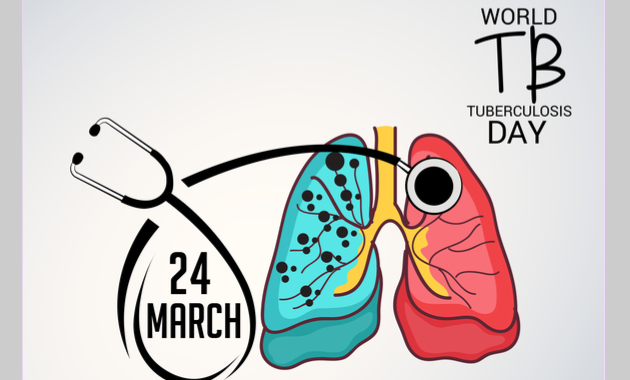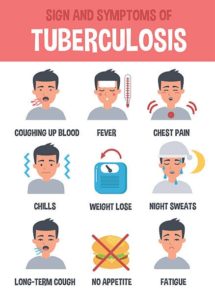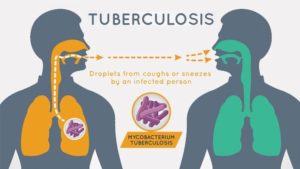
Table of Contents
What is Tuberculosis (TB)?
- Tuberculosis is a bacterial infection that spreads through the droplet from the cough or sneeze of an infected person.
- Tuberculosis (TB) is a serious infectious disease that can affect any part of the body but is mainly affects the lungs.
- Tuberculosis is potentially fatal and contagious disease caused by Mycobacterium tuberculosis and spread to any part of the body such as meninges, kidney, lymph nodes and bones.
Key Facts about TB
- TB is 13th leading cause of death worldwide and second most infectious disease
- In year 2020, about 10 million people fell ill from TB and about 1.5 million lost their life from TB
- TB is present in every country and among all age groups but this disease is totally preventable and curable
- In addition to be there is multidrug resistant TB which is still a public health crisis and health security threat
- In year 2020 only about 1 in 3 multidrug resistant TB patient received treatment
- However, the global TB incidence is decreasing with 2% every year from 2015 to 2020
- Sustainable development goals (SDGs) also have set a target to end TB epidemic by the year 2030
- Every year, March 24 is celebrated as ‘World TB Day’.
Causes of TB
- The major causative agent is Mycobacterium tuberculosis in human.
- Other causative agents include Mycobacterium bovis, Mycobacterium africanum, and Mycobacterium microti
- It is usually spreads from droplet infection from person to person.
- Although TB is contagious, it is not easy to get TB. A person who has treatment for 2 weeks can no longer transfer TB
Types of TB
1. Latent TB
- This means the bacteria is inside the human body in an inactive state but are not contagious.
- In this case, the immune system prevents the bacteria from spreading in the body.
- However, bacteria have the potential to be active in cases such as weak immune system.
2. Active TB
- This means the bacteria multiply and are in contagious stage which makes us sick.
- 90% of active cases of TB comes from latent TB infection.
Classification of TB
1. Pulmonary TB
- It is the type of TB in which the bacteria invade the lungs and has the potential to cause death but with right medication it can be cured.
- It can either be primary affecting the new individual who are not previously infected or secondary where the reinfection occurs.
2. Extra pulmonary TB
- TB outside the lungs is extra pulmonary TB
- When the tuberculosis bacteria affect other parts of the body other than lungs, it is called as extra pulmonary TB
- If diagnosed early, this can also be cured.
Risk factors of TB
- Close contact with the ones who have active TB
- Immune compromised status such as HIV/AIDS, elderly, cancer, etc.
- Drug abuse and alcoholism
- Lack of adequate health care
- Pre-existing medical conditions such as diabetes, chronic heart conditions
- Immigrants from high incidence TB cases
- Occupation like asbestosis mining, working in health care facilities
- Long term institutionalization in hospital setting
Risk groups of TB
- TB mostly affects the working group but doesn’t leave other age groups. All age groups are at risk of TB
- Those suffering from other infectious disease are at most risk groups
- People infected with HIV are 18 times more likely to suffer from TB too and people with under nutrition are 3 times more likely
- People who use alcohol and tobacco smoke have risk factor 3.3 and 1.6 respectively to suffer from TB
- Therefore, a healthy immune system can fight back TB strongly. However, a person’s immune system may not be able to fight back TB if he/she has:
- HIV/AIDS
- Diabetes
- Severe kidney disease
- Cancer or its treatment such as chemotherapy
- Low body weight
- Poor nutrition
- Medication for organ transplants
- Head and neck cancers
- is taking certain drugs to treat rheumatoid arthritis, psoriasis, Crohn’s disease
Some Myths and Misconceptions About TB
- TB runs in the family; it is a genetic/heredity disease
- There is no cure for TB
- It affects only smokers
- It occurs only in the lungs
- TB is highly contagious and any contact to TB patient means death
- Coughing out blood in sputum means TB
- It is a disease of lower socio-economic class
- Treatment of TB is very expensive
Signs and Symptoms of TB

- Cough for more than 3 weeks
- Fever
- Loss of appetite
- Unintended weight loss
- Chest pain, or pain during breathing or coughing
- Blood in the cough
- Chills
- Night sweats
- Feeling tired/fatigue all the time
Screening for TB
Screening is a reasonable identification of unrecognized illness/disease in an apparently healthy, asymptomatic individual by means of tests or experiments.
The Centers for Disease Control and Prevention (CDC) recommends that people who have an increased risk of tuberculosis be screened for latent TB infection. This recommendation includes people who:
- Have HIV/AIDS
- Use IV drugs
- Are in contact with infected people
- Are from a country where TB is common, such as several countries in Latin America, Africa and Asia
- Live or work in areas where TB is common, such as prisons or nursing homes
- Work in health care and treat people with a high risk of TB
- Are children who are exposed to adults at risk of TB
Diagnosis of TB
- History collection
- Physical examination
- Sputum test
- Blood test: also known as interferon-gamma release assays (IGRAs)
- Mantoux test: also known as Mantoux tuberculin skin test
- Chest X-ray
Preventive Measures of TB
- Isolation of the patient with active TB
- Use of personal protective measures such as masks, gloves while in contact with patient
- BCG vaccination
- Proper ventilation in home and work areas with proper sunlight
- Regular medications and follow up
- Completing the prescribed medications
- Nutritional therapy and lifestyle modifications
Treatment of TB
- TB is treatable and curable disease
- It is treated with standard course of 6 months with 4 antimicrobial drug also known as first line treatment regimen
- First line treatment drug include:
- Isoniazid
- Rifampicin (Rifadin, Rimactane)
- Pyrazinamide
- Ethambutol (Myambutol)
- However, in case of drug resistant TB, a person may need additional medicines which needs to be taken for up to 30 months.
- The information to support the patient are also provided while providing the medications
Vaccination for TB
- The BCG vaccine provides protection against TB.
- The vaccine is recommended for babies, children, adults under the age of 35
What is Multidrug Resistant TB (MDR-TB)?
- Multidrug-resistant tuberculosis (MDR-TB) is a form of tuberculosis (TB) infection caused by bacteria that are resistant to treatment with at least two of the most powerful first-line anti-TB medications (drugs), isoniazid and rifampin.
- Multidrug Resistant TB is caused by the strains of Mycobacterium tuberculosis which is resistant to rifampicin and isoniazid which are the most effective TB treatment drug
- MDR-TB is curable by the use of second line drug treatment regimen
- MDR-TB is laboratory diagnosis not a clinical assumption
- Inappropriate drug delivery and drug regimen are major reasons for drug resistance
- Over the counter anti-TB and failure to implement DOTs are also the contributing factors
- MDR-TB is suspected when there is sputum smear positive after the three months of intensive treatment
- Close contact with MDR-TB patient can also transfer this
References and For More Information
https://www.who.int/news-room/fact-sheets/detail/tuberculosis
https://www.cdc.gov/tb/topic/basics/default.htm
https://www.lung.org/lung-health-diseases/lung-disease-lookup/tuberculosis/symptoms-diagnosis
https://medlineplus.gov/tuberculosis.html
https://www.mayoclinic.org/diseases-conditions/tuberculosis/diagnosis-treatment/drc-20351256
https://www.webmd.com/lung/understanding-tuberculosis-basics
